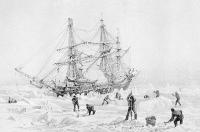
HMS Terror trapped in the ice
In an interesting historical coincidence, just days after the luxury cruise ship, Crystal Serenity, completed a passage through the Canadian Arctic’s Northwest Passage, HMS Terror has been found. HMS Terror is the second of two ships from Sir John Franklin’s ill-fated expedition to traverse the Northwest Passage. The ship sank after being abandoned in the Arctic ice 168 years ago. The wreck of HMS Terror was found on September 3, appropriately enough, in Terror Bay, which is located on the southwest shore of King William Island, in Nunavut. The wreck lies lies 60 miles (96km) south of where experts have long believed the ship was crushed by ice.
The discovery was tied to to local knowledge. The Week reports: An Inuk crewman on the team’s research ship, Sammy Kogvik, 49, was talking with the Arctic Research Foundation’s operations director, Adrian Schimnowski, when he recalled a hunting trip in Terror Bay, where he posed for a picture with a large piece of wood sticking out of the sea ice, which resembled a mast. When Kogvik got home and discovered his camera gone, he decided not to speak of the experience, believing the missing camera was an omen of the bad spirits that wander the island. But by following Kogvik’s tip, the researchers focused on the north end of Victoria Strait, eventually making their fateful discovery.
The wreck of HMS Terror is said to be in pristine condition. As reported by the Guardian: On Sunday, a team from the charitable Arctic Research Foundation manoeuvred a small, remotely operated vehicle through an open hatch and into the ship to capture stunning images that give insight into life aboard the vessel close to 170 years ago.
In 1845, Captain Sir John Franklin departed England bound for the Northwest Passage aboard HMS Erebus and HMS Terror, and never returned. All 129 officers and men were lost. Searches for the lost expedition continued throughout the 19th century and intermittently, well into the 21th. The wreck of Franklin’s other ship, HMS Erebus was located in 2014.
Both HMS Terror and HMS Erebus were built as “bomb ships” which carried heavy mortars. Because bomb ships were very heavily built, they were often refitted for exploration, particularity in ice. HMS Terror, built in 1813, participated in the unsuccessful British assaults on Stonington, CT and Fort McHenry in Baltimore, MD during the War of 1812. The ship also served as an exploration ship in two Arctic expeditions prior to the doomed Franklin expedition.
Underwater footage shows ‘perfectly preserved’ HMS Terror
Thanks to Alan Rice, Alaric Bond, Lee Fox and Miroslav Antic for contributing this post.

One found this most interesting as during the Western Arctic Patrol 1967, Canada’s Confederation Year, from September 08 through September 11 as a Watchofficer in the Canadian Coastguard Icebreaker CCGS Camsell we were laying ice bouys along the Simpson Strait. Looking in my logbook from that time and our route chart we passed just South of Terror Bay. We had left from Cambridge Bay set our course eastwards down Queen Maud Gulf, Storis Passage to an anchorage off Gladman Point. After the buoy laying, made from 40 gallon (imperial) drums, we set course northwards from Bead Island to Spence Bay recording track soundings and laying buoys on passage. One noted that the temperature was 20° F. at the time !!
Little did we then know H.M.S. Terror was so close at hand – well that’s the Arctic. These notes are from 49 years ago so it is just as well one kept a Logbook.
Good Watch.
Very interesting.
I still have been unable to find why Terror Bay was named Terror Bay. The HMS Erasmus was found roughly where local tribes said it would be. I wonder if locals had an oral tradition of where Terror sank or whether the name was coincidence.
It is truly ironic that the HMS Terror was found in Terror Bay. There are many terrain features on King William Island that are named after individuals connected with the Franklin Expedition. Two bays are named Erebus Bay and Terror Bay after the expeditions ships (HMS Erebus and HMS Terror). The names were given to these features mainly by European explorers who were looking into the fate of the expedition. The native Inuit had nothing to do with this naming. I believe that Terror Bay was named by Sir Francis Leopold McClintock during his 1857-59 expedition to the island.